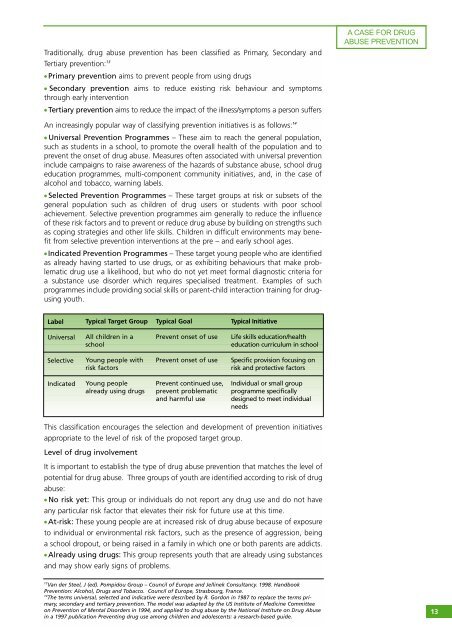PDF (Lessons learned in drug abuse prevention: a global review)
PDF (Lessons learned in drug abuse prevention: a global review)
PDF (Lessons learned in drug abuse prevention: a global review)
Create successful ePaper yourself
Turn your PDF publications into a flip-book with our unique Google optimized e-Paper software.
Traditionally, <strong>drug</strong> <strong>abuse</strong> <strong>prevention</strong> has been classified as Primary, Secondary and<br />
Tertiary <strong>prevention</strong>: 13<br />
● Primary <strong>prevention</strong> aims to prevent people from us<strong>in</strong>g <strong>drug</strong>s<br />
A CASE FOR DRUG<br />
ABUSE PREVENTION<br />
● Secondary <strong>prevention</strong> aims to reduce exist<strong>in</strong>g risk behaviour and symptoms<br />
through early <strong>in</strong>tervention<br />
● Tertiary <strong>prevention</strong> aims to reduce the impact of the illness/symptoms a person suffers<br />
An <strong>in</strong>creas<strong>in</strong>gly popular way of classify<strong>in</strong>g <strong>prevention</strong> <strong>in</strong>itiatives is as follows: 14<br />
● Universal Prevention Programmes – These aim to reach the general population,<br />
such as students <strong>in</strong> a school, to promote the overall health of the population and to<br />
prevent the onset of <strong>drug</strong> <strong>abuse</strong>. Measures often associated with universal <strong>prevention</strong><br />
<strong>in</strong>clude campaigns to raise awareness of the hazards of substance <strong>abuse</strong>, school <strong>drug</strong><br />
education programmes, multi-component community <strong>in</strong>itiatives, and, <strong>in</strong> the case of<br />
alcohol and tobacco, warn<strong>in</strong>g labels.<br />
● Selected Prevention Programmes – These target groups at risk or subsets of the<br />
general population such as children of <strong>drug</strong> users or students with poor school<br />
achievement. Selective <strong>prevention</strong> programmes aim generally to reduce the <strong>in</strong>fluence<br />
of these risk factors and to prevent or reduce <strong>drug</strong> <strong>abuse</strong> by build<strong>in</strong>g on strengths such<br />
as cop<strong>in</strong>g strategies and other life skills. Children <strong>in</strong> difficult environments may benefit<br />
from selective <strong>prevention</strong> <strong>in</strong>terventions at the pre – and early school ages.<br />
● Indicated Prevention Programmes – These target young people who are identified<br />
as already hav<strong>in</strong>g started to use <strong>drug</strong>s, or as exhibit<strong>in</strong>g behaviours that make problematic<br />
<strong>drug</strong> use a likelihood, but who do not yet meet formal diagnostic criteria for<br />
a substance use disorder which requires specialised treatment. Examples of such<br />
programmes <strong>in</strong>clude provid<strong>in</strong>g social skills or parent-child <strong>in</strong>teraction tra<strong>in</strong><strong>in</strong>g for <strong>drug</strong>us<strong>in</strong>g<br />
youth.<br />
Label<br />
Typical Target Group<br />
Typical Goal<br />
Typical Initiative<br />
Universal<br />
All children <strong>in</strong> a<br />
school<br />
Prevent onset of use<br />
Life skills education/health<br />
education curriculum <strong>in</strong> school<br />
Selective<br />
Young people with<br />
risk factors<br />
Prevent onset of use<br />
Specific provision focus<strong>in</strong>g on<br />
risk and protective factors<br />
Indicated<br />
Young people<br />
already us<strong>in</strong>g <strong>drug</strong>s<br />
Prevent cont<strong>in</strong>ued use,<br />
prevent problematic<br />
and harmful use<br />
Individual or small group<br />
programme specifically<br />
designed to meet <strong>in</strong>dividual<br />
needs<br />
This classification encourages the selection and development of <strong>prevention</strong> <strong>in</strong>itiatives<br />
appropriate to the level of risk of the proposed target group.<br />
Level of <strong>drug</strong> <strong>in</strong>volvement<br />
It is important to establish the type of <strong>drug</strong> <strong>abuse</strong> <strong>prevention</strong> that matches the level of<br />
potential for <strong>drug</strong> <strong>abuse</strong>. Three groups of youth are identified accord<strong>in</strong>g to risk of <strong>drug</strong><br />
<strong>abuse</strong>:<br />
● No risk yet: This group or <strong>in</strong>dividuals do not report any <strong>drug</strong> use and do not have<br />
any particular risk factor that elevates their risk for future use at this time.<br />
● At-risk: These young people are at <strong>in</strong>creased risk of <strong>drug</strong> <strong>abuse</strong> because of exposure<br />
to <strong>in</strong>dividual or environmental risk factors, such as the presence of aggression, be<strong>in</strong>g<br />
a school dropout, or be<strong>in</strong>g raised <strong>in</strong> a family <strong>in</strong> which one or both parents are addicts.<br />
● Already us<strong>in</strong>g <strong>drug</strong>s: This group represents youth that are already us<strong>in</strong>g substances<br />
and may show early signs of problems.<br />
13 Van der Steel, J (ed). Pompidou Group – Council of Europe and Jell<strong>in</strong>ek Consultancy. 1998. Handbook<br />
Prevention: Alcohol, Drugs and Tobacco. Council of Europe, Strasbourg, France.<br />
14 The terms universal, selected and <strong>in</strong>dicative were described by R. Gordon <strong>in</strong> 1987 to replace the terms primary,<br />
secondary and tertiary <strong>prevention</strong>. The model was adapted by the US Institute of Medic<strong>in</strong>e Committee<br />
on Prevention of Mental Disorders <strong>in</strong> 1994, and applied to <strong>drug</strong> <strong>abuse</strong> by the National Institute on Drug Abuse<br />
<strong>in</strong> a 1997 publication Prevent<strong>in</strong>g <strong>drug</strong> use among children and adolescents: a research-based guide.<br />
13
















